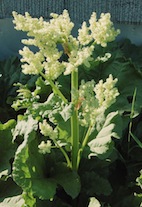Jing Chen and colleagues at Winship Cancer Institute recently published a paper in Molecular Cell. Most of the paper deals with a metabolic enzyme, 6PGD (6-phosphogluconate dehydrogenase), and how it is more active in cancer cells.

Rheum palmatum/Chinese rhubarb/da-huang
Tucked in at the end is a note that an inhibitor of 6GPD with an odd name, physcion, has anticancer activity in Chen’s team’s hands. Physcion, also known as parietin, is an orange-yellow pigment extractable from lichens and Chinese rhubarb that has been employed as an anti-mildew agent.
Probing cancer cells’ warped metabolism is a promising approach, for both drug discovery and finding effective ways to combine existing drugs, because of the Warburg effect: cancer cells’ tendency to suck up lots of sugar and use it in energy-inefficient ways. Read more




